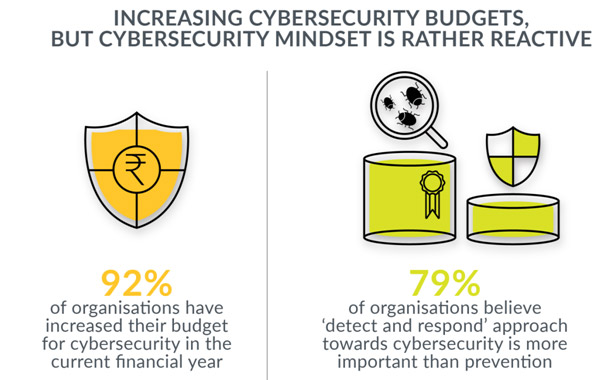Despite increased spending, Palo Alto Networks study revealed 41 per cent of companies in India have lost over 64 lakhs in the current financial year
Palo Alto Networks announced the results of its report entitled ‘The State of Cybersecurity in Asia-Pacific’, which revealed that cyber security budgets have increased for 92 per cent of organizations in India. This survey was conducted to help gain deep insights around behavior and attitudes towards cyber security throughout the Asia-Pacific region, including India.
Key findings in India revealed:
- There has been recent growth in cyber security budgets: Businesses acknowledge the importance of ensuring business continuity amidst the persistence and growing sophistication of cyber threats, and 92 per cent of organizations have increased their budget for cyber security in this financial year.
- Internal and external challenges contribute to cyber security issues: The three major cyber security challenges organizations face are employees’ lack of cyber security awareness (47 per cent), risk from third-party services (43 per cent) and migration to the cloud (35 per cent).
- ‘Detect and respond’ approach overrules a ‘breach prevention’ strategy, but this needs to be revisited: 79 per cent of respondents indicated their organizations place more importance on detection and response to cyber threats than prevention. Data breaches remain costly, meanwhile, with 41 per cent of respondents revealing they have lost at least ₹ 64,55,500 (US$100,000) in the financial year 2016-17 due to such breaches. This raises question around the effectiveness of responding to threats only after incidents are detected, rather than taking a preventive stance.
- Cybersecurity measures adopted are rather basic: According to the survey, organizations predominantly adopt basic security measures. Respondents indicated the highest adoption rates for anti-virus (77 per cent) and firewall (74 per cent), whereas anti-ransomware (37 per cent), two-factor authentication (35 per cent) and biometrics (46 per cent) have fallen on the lower end of the spectrum.
- Organizations are filling their need for dedicated cyber security talent: 95 per cent of Indian organizations feel they have a strong hold of dedicated IT teams against cyber threats – a notably high figure compared to other APAC countries with only 84 percent. Manufacturing and finance sectors are the top verticals when it comes to ensuring they are well-equipped with a professional team to prevent cyber threats.
Across the Asia-Pacific region, the key finding from the report is the need to promote greater cyber security awareness and education among organizations. While budgets are increasing, 46 per cent of Asia-Pacific organizations are struggling to keep up with the increasingly sophisticated cyber threats and finding the appropriate solutions to combat them.
Sean Duca, vice president and regional chief security officer for Asia-Pacific, Palo Alto Networks said, ‘Internal and external threats look like the biggest loophole causing organizations costly data breaches. Therefore, these organizations should revisit their cyber security strategy and assess whether the widely-adopted ‘detect and respond’ approach may be reacting to threats a little too late. As cyber threats become increasingly sophisticated, businesses should ensure that networks are adequately secured with a next-generation security platform that looks at prevention rather than remediation.”




